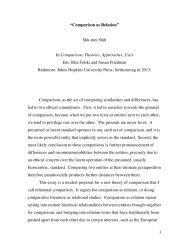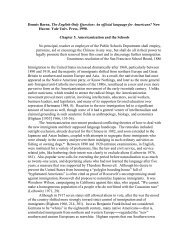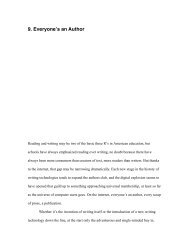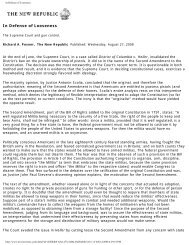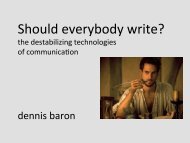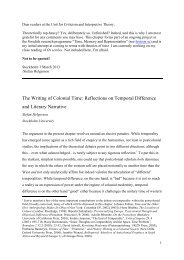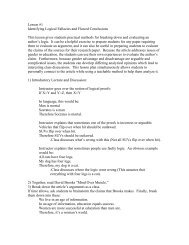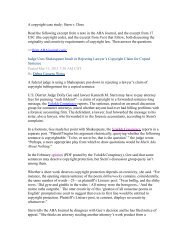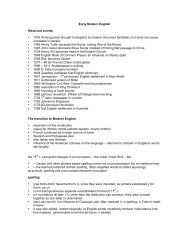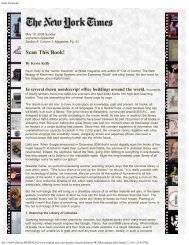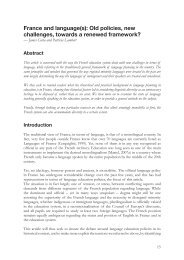Technics of the Subject: The Avatar-Drive Emily Apter - English
Technics of the Subject: The Avatar-Drive Emily Apter - English
Technics of the Subject: The Avatar-Drive Emily Apter - English
Create successful ePaper yourself
Turn your PDF publications into a flip-book with our unique Google optimized e-Paper software.
has determinate effects. It is an agency, only without an agent: a subjectless subjectivity" (xxiv).<br />
<strong>The</strong> Lacanian counterpart would be "subjectivization without a subject," identified with that<br />
moment in a patient's analysis in which he "experiences <strong>the</strong> fantasy <strong>of</strong> becoming <strong>the</strong> drive" (95).<br />
<strong>Avatar</strong>ity<br />
Who is <strong>the</strong> "character" <strong>of</strong> this system-subject? Not to be confused with <strong>the</strong> protagonist <strong>of</strong><br />
cyberfiction (epitomized by William Gibson's "Case" in Neuromancer, who acts like a traditional<br />
character despite being "jacked into" a network), <strong>the</strong> subject <strong>of</strong> technics, as I am defining it, is<br />
really a way <strong>of</strong> construing <strong>the</strong> ontology <strong>of</strong> "what-ness" and "who-ness," or <strong>the</strong> "'It in <strong>the</strong> I'" <strong>of</strong><br />
agency, once <strong>the</strong> subject is framed as cognitive and affective algorithm, or a systemic<br />
configuration <strong>of</strong> <strong>the</strong> drives.<br />
<strong>The</strong> character could, in this respect, be identified with <strong>the</strong> avatar. <strong>The</strong> avatar has emerged in <strong>the</strong><br />
last ten years as a familiar character-player, custom-built from a commodified menu <strong>of</strong> enhanced<br />
body parts and facial features, and assigned a starring role in game spaces, MMORGs (<strong>the</strong><br />
acronym for Massive Multi-player Online Role Play Game), and online communities like <strong>The</strong><br />
Sims, Second Life, Eve Online, EverQuest, Proxy and World <strong>of</strong> Warcraft. <strong>The</strong> avatar might also<br />
be identifiable as a totem; less a second self or alter-ego than an animal companion or emblem.8<br />
<strong>Avatar</strong> identity, in o<strong>the</strong>r words, is no fixed entity; it can be an anthropological proxy, but it might<br />
equally well take an indistinct form that is pure materiality, what Alex Galloway describes, in<br />
relation to <strong>the</strong> hive or swarm, as an "autochtonous material phenomenon unrestrained by <strong>the</strong><br />
projection <strong>of</strong> a human spirit within" ("StarCraft" 93). In Galloway's framework, <strong>the</strong> avatar is<br />
possessed <strong>of</strong> agential characteristics operating within a projected technical imaginary (something<br />
like cyberspace) that is held apart from an actual body. Here <strong>the</strong> avatar stands in marked contrast<br />
to Jean-Luc Nancy's concept <strong>of</strong> l'intrus (<strong>the</strong> "intruder" hosted by <strong>the</strong> human). After receiving a<br />
heart transplant, Nancy wrote: "If my own heart has deserted me, up to what point was it 'mine,'<br />
my proper organ? Was it even an organ? . . . . <strong>The</strong>re is an intruder in me and I become a stranger<br />
to myself" (13-15).9 Where <strong>the</strong> implant represents <strong>the</strong> alienability <strong>of</strong> self-property it falls short <strong>of</strong><br />
dispensing entirely with <strong>the</strong> fiction <strong>of</strong> a "human spirit within." By comparison, <strong>the</strong> avatar takes<br />
shape as <strong>the</strong> pros<strong>the</strong>tic extension <strong>of</strong> desubjectivated agency, as in a joystick or mouse.<br />
Philologically speaking, <strong>the</strong> word avatar derives from avatara, a Sanskrit term that breaks down<br />
into ava––"down"––and tarati––"he goes, passes beyond." <strong>The</strong> word is traced by Gregory Little's<br />
1999 A Manifesto for <strong>Avatar</strong>s to <strong>the</strong> Fourth Teaching in <strong>the</strong> Bhagavad gita, specifically to<br />
Krishna's phrase, "when goodness grows weak, when evil increases, I make myself a body."<br />
"Originally referring to <strong>the</strong> incarnation <strong>of</strong> Hindu deities," according to Little, "avatars in <strong>the</strong><br />
computing realms have come to mean any <strong>of</strong> <strong>the</strong> various 'strap-on' visual agents that represent<br />
<strong>the</strong> user in increasing numbers <strong>of</strong> 2 and 3D world" (2). As distinct from <strong>the</strong> cyborg, avatars are<br />
more fully fused with <strong>the</strong> human user. Little claims that <strong>the</strong> cyborg (christened in 1960 by<br />
Manfred E. Clynes and Nathan S. Kline's article on "Cyborgs in Space"), "incorporates body and<br />
pros<strong>the</strong>ses in <strong>the</strong> forms <strong>of</strong> mechanical, optical, coded, pharmacological, electronic, telematic,<br />
genetic, and biological agents, hosted by an original human consciousness to form a unified but<br />
hybrid lived body" (Little 2). By contrast <strong>the</strong> avatar "is a mythic figure with its origin in one<br />
world and projected or passing through a form <strong>of</strong> representation appropriate to a parallel world.<br />
<strong>The</strong> avatar is a delegate, a tool or instrument allowing an agency to transmit signification to a<br />
parallel world" (3).<br />
4


